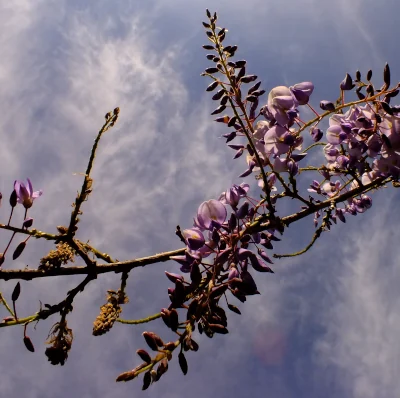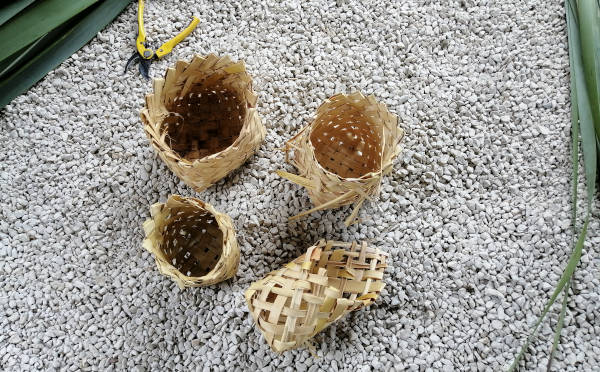Basket weaving materials from plants
Climbers and Trailers
In many case little work is required to prepare and some can be woven immediately after gathering. Can be used stripped or unstripped – best stripped when green. To store – remove leaves, tie into coils small enough to fit into a container for soaking later. Will probably need soaking before use.
Blackberries, raspberries (Rubus spp)
Red, brown, green with interesting texture. Generally strong and pliable but vary in strength and length. Traditionally used for stitching coiled rye baskets and bee skeps. Remove any thorns by drawing a hand in a thick glove, from tip to base and then in the other direction. Use as soon as possible. Canes can be split.
Clematis
Creamy when stripped. Weak joints. See honeysuckle for how to peel.
Grapevines (Vitis spp)
Can be gathered any time. Ideal for large, strong baskets. Easily split and these half round sections are good for rims and hoops and frames of rib baskets. Keep the vines soaked while working.
Honeysuckle
Gather in spring or summer. Use for wickerwork, coiling core and rib basket weaver. Choose vines that are away from the main tangle as they grow long and straight in search of a support and may have fewer leaves. Garden varieties tend to have longer stems, but tangled wild stems can be used without unravelling. Strip off any leaves by running your hand down the vine. Coil each vine separately.
Use stripped as the fibres shred, (though this may be the desired look). To strip off the bark tie into a coil and boil for 3-4 hours. If the bark doesn’t come away easily then rub with a plastic mesh pot scrubber. Boiling also helps strengthen fibres. Coil again to dry and store. Will store for months, even years. Soak in warm water for at least an hour before use.
Hop (Humulus lupus)
Wild hop stems have a rough texture and are unpleasant to use, garden varieties (eg H lupus aureus) kinder to hands. Cannot be soaked so use before too dry. Flowers can be kept on as a decorative touch.
Ivy (Hedera spp)
Useful for decorative leaves, choose stems with small leaves. Leaves can be preserved by soaking cut stems in solution of glycerine (1 glycerine: 2 water) for 4-5 days. See honeysuckle for how to peel.
Periwinkle (Vinca spp)
Use the light coloured stems for slath tying or weaving small baskets.
Roses (Rosa spp)
Collect canes and stems in autumn or winter. Remove leaves and thorns with a gloved hand, boil to remove bark. Coil and dry for 2 – 4 weeks to allow for shrinkage before use. Pliable stems used for wickerwork and more brittle ones for hoops and ribs in rib baskets. Dog rose (Rosa caninis) is a striking green, thorns can be removed individually.
Virginia creeper (Parthenocissus quinquefolia)
Gather in summer. Can be used when fresh if pliable enough or after storing. Remove leaves but nodes and bumps give an interesting texture when woven. For wickerwork and rib baskets.
Winter flowering jasmine (Jasminum nudiflorum)
Will keep its colour if weather just for a short time.
Wisteria
Stems and vines can be used. Supple and strong. Can be used stripped or unstripped. For wickerwork, rib baskets hoobs and ribs. Bark can be used for coiling stitching. Harvest spring, summer and autumn. Use whole or strip while still green.
Also: Akebia, Boston ivy (Parthenocissus trisupidata), morning glory.
Coppiced or pollarded rods / tree branches and shoots
Lime (Tilia spp)
Stems that have been in bright sunlight have the best colour.
Willow (Salix spp)
Brown willow has been dried with the bark left on.
Buff willow is brown willow that has been boiled and peeled – tannins in the bark give it this colour during boiling
White willow has had the bark stripped off in spring.
Buff willow should be soaked between 30 minutes and 2 hours, white will take a little longer, brown from 2 days to 2 weeks. Then mellow in a damp cloth such as an old towel or blanket, for a few hours or preferable overnight. This will allow moisture to soak through the willow. Buff and brown willow will stay useable for 2 days then will go mouldy. Brown willow can be kept for up to a week like this.
Varieties
- S babylonica – weeping willow, withies for wickerwork and weavers for rib baskets. Gather in spring before leaves appear rods can be pruned or fallen rods gathered from the ground. Coil and use immediately or store. Soak before weaving.
- S daphinoides – purplish bloom
- S discolour – Pussy willow used for wickerwork
- S japonica – shiny pink pussy willow buds in spring
- S nigra – black willow – rods and roots – for weavers and hoops and loops for rib baskets.
- S purpurea – purple willow, twigs and withies used for wickerwork, plaiting, weavers, hoops and loops in rib baskets
- S sachalinensis – flattened curved branches
- S triandra – twigs and withies used for wickerwork, plaiting, weavers, hoops and loops in rib baskets
- S viminalis – twigs and withies used for wickerwork, plaiting, weavers, hoops and loops in rib baskets
- S vitellina – bright yellow shoots


